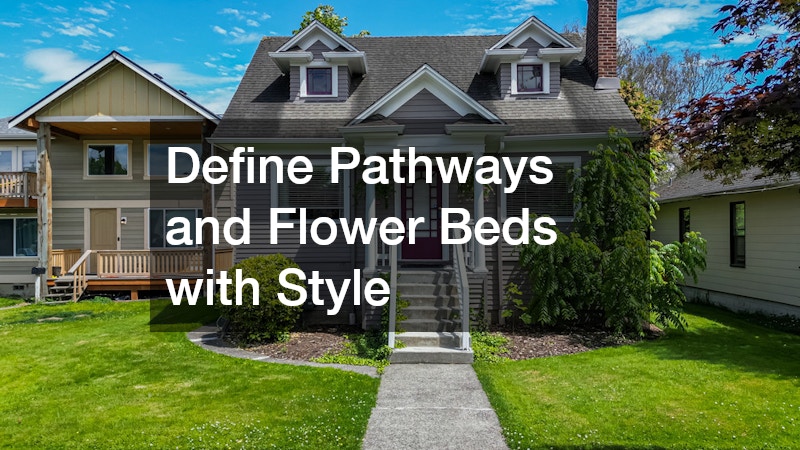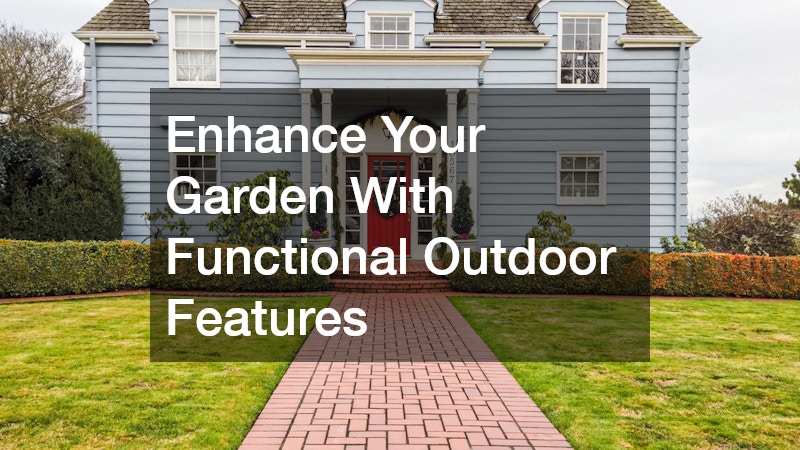A compact front garden can have a big impact on the overall look and feel of your home. Even if your outdoor space is limited, thoughtful planning and clever design choices can transform it into a welcoming oasis that enhances curb appeal and adds functionality. Whether you dream of a lush green retreat, a neat and modern entrance, or a low-maintenance space with stylish accents, creating a small front garden that reflects your personality and lifestyle is entirely possible with the right approach.
The secret lies in maximizing every inch of available space while keeping your design both practical and visually appealing. From plant selection and layout planning to adding functional features like pathways, seating areas, and even water elements, a well-designed front garden blends beauty with usability. Careful attention to detail—such as choosing native plants, using the right materials for edging, and ensuring soil health—can make your space not only attractive but also easy to maintain.
Discover everything you need to know to plan a stylish small front garden that feels spacious, organized, and welcoming. We’ll explore ways to work with local experts, incorporate native greenery, prevent pest damage, and even add functional features. With the right tools, inspiration, and a clear plan, your little garden can become one of the most inviting parts of your home.
Get the Right Advice for Your Garden Design
When planning a compact garden, working with the right professionals can make all the difference. While it’s possible to create a design on your own, enlisting the help of local landscapers can ensure your vision comes to life in a practical, beautiful, and sustainable way. These professionals bring valuable expertise, from plant selection to layout optimization, helping you make the most of your limited space and avoid design pitfalls that can waste time and resources.
Local landscapers are especially beneficial because they understand your region’s climate, soil, and seasonal conditions. They can recommend plants that thrive in your environment, suggest durable materials for pathways or edging, and provide design solutions that work well in compact areas. For example, they might advise creating vertical planting walls, incorporating drought-tolerant species, or using raised beds to maximize growing space without overcrowding.
Even a consultation with a landscaping professional can help you avoid costly mistakes and ensure your small front garden remains both stylish and functional for years to come. Whether you want a lush, green look or a modern minimalist design, a professional touch can turn your ideas into a polished reality while also boosting your home’s curb appeal.

Incorporate Native Plants for Easy Maintenance
One of the smartest choices you can make for any garden is to use native plants and local trees in your design. Native species are naturally adapted to your climate and soil, meaning they typically require less watering, fertilizing, and pest maintenance than non-native plants. This not only saves time and money but also makes your garden more environmentally friendly.
Incorporating local trees, even small ornamental varieties, adds height and structure without overwhelming the limited space. Consider flowering dogwoods, Japanese maples, or redbuds for their beauty and manageable size. Pair these with native shrubs, perennials, and ground covers to create a layered, textured look that feels lush yet easy to maintain.
Native plants also support local pollinators like bees and butterflies, which adds life and movement to your garden. By designing your space around plants that naturally thrive in your area, you’ll create a small front garden that looks beautiful with less effort and fewer resources.
Keep Your Garden Healthy and Damage-Free
A thriving garden depends on more than just attractive design—it also requires keeping plants healthy and safe from common threats. One of the most effective ways to protect your space is to invest in proper pest control, ensuring long-term growth and beauty.
Insects and critters can quickly damage flowers, shrubs, and even small trees if left unchecked. Choosing eco-friendly pest control methods is ideal for front gardens since these spaces are close to your home and frequented by family and pets. Options like natural sprays, companion planting (such as marigolds to repel aphids), and introducing beneficial insects like ladybugs or lacewings can help keep harmful pests at bay without relying heavily on chemicals.
Routine inspections are key to spotting issues early. Check for leaf discoloration, holes, curling leaves, or sticky residue—clear signs that pests may be present. You can also examine the soil surface for larvae or hidden infestations. By taking a proactive approach to pest control, you’ll make sure that your small front garden remains healthy, vibrant, and welcoming throughout the year, adding both beauty and value to your home.
Add Structure and Levels to Your Outdoor Space
One of the challenges of designing a small front garden is making it feel spacious while still incorporating various elements. Adding retaining walls can be a stylish and functional solution. Not only do they help manage sloped terrain, but they also create defined levels and sections, adding depth and visual interest to your garden.
Retaining walls can be built from natural stone, brick, or concrete blocks, depending on the aesthetic you want. They provide excellent opportunities for raised planting areas, which can showcase colorful flowers, ornamental grasses, or even small shrubs. In smaller spaces, these walls double as seating areas, maximizing functionality without sacrificing design.
In addition to their beauty, retaining walls protect soil and prevent erosion, making them both practical and stylish. By incorporating these features into your compact garden, you can turn an ordinary yard into a multi-dimensional, well-organized outdoor space.

Define Pathways and Flower Beds with Style
In a small garden, organization is everything—and one of the best ways to achieve a neat and structured look is with concrete edging. This simple addition can make a dramatic difference, clearly separating pathways, lawns, and flower beds while adding a clean, polished appearance.
Concrete edging comes in various styles, from sleek modern lines to textured finishes that mimic stone or brick. It enhances the garden’s visual appeal and helps keep mulch, soil, and plants neatly contained. With a small front garden, even subtle design elements like edging can have a big impact, making the space look intentional and well cared for.
Pathways framed with concrete edging create clear routes through your garden, making the area more inviting and easier to navigate. Whether you prefer curved lines for a softer look or straight borders for a contemporary style, this feature is both practical and decorative.
Create a Relaxing Water Feature for Your Entrance
A compact garden can instantly feel more serene with the addition of a water feature like a koi pond. While it may seem like a luxury, even a modestly sized pond can become the focal point of your garden, offering movement, sound, and a calming presence that sets the tone for your entire outdoor space.
Koi ponds bring a sense of elegance and tranquility while supporting aquatic plants like lilies, lotus, and water hyacinths. They also attract birds, butterflies, and even beneficial insects, adding life and vibrancy to your garden. For small spaces, raised or container-style ponds are excellent options, providing the same relaxing effect without taking up much room, while also allowing more flexibility in placement.
Professional installation ensures the pond is safe, properly lined, and easy to maintain over time. Features like discreet filtration systems, stone edging, and underwater lighting can elevate the design further. Paired with soft lighting, nearby seating, and lush surrounding greenery, a koi pond can transform your small front garden into a welcoming retreat you’ll look forward to coming home to every single day.

Enhance Your Garden With Functional Outdoor Features
When designing a small front garden, think beyond plants and flowers. Functional outdoor features installed by professional hardscape installers can elevate the space and make it more versatile. Hardscaping includes elements like patios, stone pathways, decorative walls, and seating areas—all of which add style and usability.
Hardscaping helps create structure and balance in a compact space. For example, a small stone patio with a bench can provide a cozy seating area, while a pathway of decorative pavers adds charm and guides visitors through your garden. Hardscape installers can also help integrate practical features like lighting, raised planters, or built-in seating, making sure every inch of your garden is put to good use.
The key is to seamlessly blend hardscaping with plants and greenery so that the overall effect is both functional and beautiful.
Prevent Soil Loss and Protect Your Plants
Healthy soil is the foundation of any successful garden, and preventing erosion is a crucial step in protecting your investment. Using the right erosion control products can help stabilize the soil, support plant growth, and keep your garden looking its best.
Options like erosion control blankets, coir logs, or retaining walls prevent soil from washing away during heavy rain. Ground cover plants and mulching are also effective, adding an extra layer of protection while enhancing your garden’s appearance.
Incorporating erosion control products not only safeguards your plants but also ensures the layout of your garden remains intact over time. With these tools, your small front garden will continue to look organized, lush, and well cared for, even through changing weather conditions.

Expand Your Living Space Outdoors
A garden doesn’t just have to be decorative—it can also become a functional extension of your living space. Partnering with a skilled deck builder can help you create a cozy front deck or porch area where you can relax, sip your morning coffee, entertain a guest, or simply greet neighbors with ease.
Even a compact deck can make a big difference, especially when paired with potted plants, outdoor furniture, decorative railings, or even a built-in bench for additional seating. Materials like composite wood, pressure-treated lumber, or natural cedar ensure durability while blending seamlessly with the rest of your garden design and matching your home’s exterior style.
By adding a deck, you transform your small front garden from a simple entryway into a multifunctional outdoor living area, increasing both your home’s appeal and day-to-day usability. With thoughtful design, it can serve as a charming focal point while still leaving plenty of room for greenery.
Add Storage Without Sacrificing Style
In a small front garden, storage can be tricky—but a well-designed shed provides the perfect solution without compromising style. Modern sheds come in compact, attractive designs that complement your garden while offering space for tools, seasonal décor, and gardening supplies.
Choose a shed that matches your home’s aesthetic, whether you prefer a sleek contemporary look or a rustic cottage-style design. Adding a shed keeps your garden organized, eliminating clutter and ensuring everything you need is within easy reach.
Incorporating smart storage can make your garden not only more beautiful but also more practical for everyday use.
Creating a stylish, compact garden is all about balancing beauty, function, and sustainability. By carefully planning your layout and making thoughtful choices, you can transform even the tiniest outdoor space into a welcoming retreat that enhances your home’s curb appeal.
Start by seeking advice from local landscapers, who can guide you through design choices tailored to your climate and soil conditions. Incorporate native plants and local trees for low-maintenance greenery, and protect your investment with effective pest control and erosion control products. Add structure and interest with retaining walls and concrete edging, and consider a focal point like a koi pond for a touch of elegance.
Hardscape installers and a skilled deck builder can further enhance the space, adding features that extend your living area and provide functional beauty. Finally, a stylish shed ensures your garden remains organized and clutter-free.
With these strategies, your small front garden can become much more than an entryway—it can be a personal sanctuary and a reflection of your home’s unique charm. Whether you want a serene retreat, a lively space full of color and movement, or a modern minimalist design, the possibilities are endless. These tips should have you well on your way to designing a small garden that’s as practical as it is beautiful.



